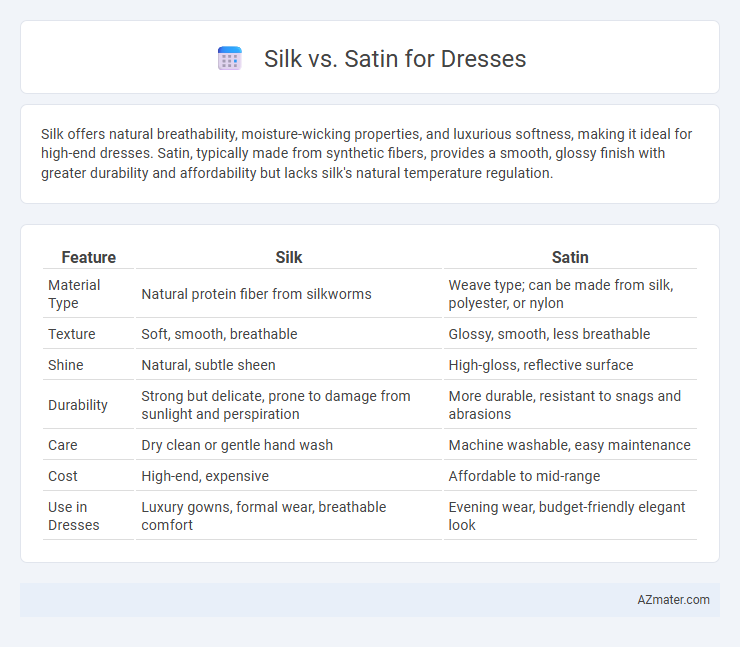Silk offers natural breathability, moisture-wicking properties, and luxurious softness, making it ideal for high-end dresses. Satin, typically made from synthetic fibers, provides a smooth, glossy finish with greater durability and affordability but lacks silk's natural temperature regulation.
Table of Comparison
| Feature | Silk | Satin |
|---|---|---|
| Material Type | Natural protein fiber from silkworms | Weave type; can be made from silk, polyester, or nylon |
| Texture | Soft, smooth, breathable | Glossy, smooth, less breathable |
| Shine | Natural, subtle sheen | High-gloss, reflective surface |
| Durability | Strong but delicate, prone to damage from sunlight and perspiration | More durable, resistant to snags and abrasions |
| Care | Dry clean or gentle hand wash | Machine washable, easy maintenance |
| Cost | High-end, expensive | Affordable to mid-range |
| Use in Dresses | Luxury gowns, formal wear, breathable comfort | Evening wear, budget-friendly elegant look |
Introduction: Silk vs Satin Dresses
Silk dresses offer a natural, breathable fabric known for its luxurious softness and hypoallergenic properties, making them ideal for sensitive skin and warm weather. Satin dresses, often made from synthetic fibers like polyester or nylon, provide a glossy finish and affordable durability, delivering high sheen without the delicate care silk requires. Both materials create elegant dresses, but silk prioritizes comfort and natural fiber benefits, while satin emphasizes affordability and a lustrous appearance.
Overview of Silk and Satin Fabrics
Silk fabric, derived from the natural protein fiber produced by silkworms, is renowned for its luxurious texture, breathability, and hypoallergenic properties, making it ideal for high-end dresses. Satin, on the other hand, is a weave pattern that can be made from silk, polyester, or nylon fibers, characterized by a glossy surface and smooth drape that enhances formal dress designs. The key distinction lies in silk being a natural fiber, while satin refers to the fabric's weave, influencing the dress's texture, sheen, and care requirements.
Key Differences Between Silk and Satin
Silk is a natural fiber derived from silkworms, offering breathability, hypoallergenic properties, and a luxurious soft texture, while satin refers to a weaving technique that can be made from various fibers, including polyester, nylon, or silk, resulting in a smooth, glossy surface and a dull back. Silk dresses provide natural temperature regulation and moisture-wicking benefits, making them ideal for sensitive skin and comfort in various climates, whereas satin dresses often prioritize aesthetic sheen and affordability over natural fiber benefits. Durability differs as silk requires delicate care like hand washing or dry cleaning, while synthetic satin variants are typically more resilient and easier to maintain.
Texture and Feel Comparison
Silk dresses offer a natural, smooth texture that feels lightweight and breathable against the skin, providing a luxurious and soft touch with excellent moisture-wicking properties. Satin dresses, while visually similar, are characterized by a glossy, shiny surface with a heavier, silky-smooth feel often made from synthetic fibers, which can trap heat and feel less breathable. The tactile difference is notable, as silk delivers a cooler, more natural drape, whereas satin offers a sleek, polished finish with a slightly stiffer hand, ideal for structured dress designs.
Appearance and Shine: Silk vs Satin
Silk dresses feature a natural, soft sheen that reflects light subtly, creating an elegant and luxurious appearance. Satin, often made from polyester or nylon, exhibits a glossy, high-shine surface that appears more reflective and smooth. The choice between silk and satin for dresses depends on whether a natural, understated glow or a vibrant, mirror-like shine is desired.
Breathability and Comfort Factors
Silk offers superior breathability due to its natural protein fibers, allowing better moisture absorption and temperature regulation compared to satin, which is often made from synthetic materials like polyester. This enhanced airflow in silk fabrics significantly improves comfort, especially in warm or humid conditions, making silk dresses ideal for extended wear. Satin's smooth texture provides a luxurious feel but can trap heat and moisture, potentially causing discomfort during prolonged use.
Durability and Maintenance
Silk dresses offer natural durability due to their protein fiber construction but require delicate care such as hand washing or dry cleaning to maintain their texture and sheen. Satin, typically made from synthetic fibers like polyester or acetate, provides higher resistance to wear and tear and is easier to maintain with machine washing options. While silk offers a luxurious feel and breathability, satin is favored for its longevity and lower upkeep demands in everyday dress use.
Price Comparison: Silk vs Satin
Silk dresses typically cost significantly more than satin due to the natural fibers and labor-intensive production process involved in silk manufacturing. Satin, often made from synthetic fibers like polyester or acetate, offers a more affordable alternative without compromising the glossy, smooth appearance. For budget-conscious shoppers, satin provides a cost-effective option while silk remains a premium choice valued for its breathability and luxurious texture.
Best Occasions for Silk and Satin Dresses
Silk dresses are ideal for formal events like weddings, galas, and upscale dinners due to their natural sheen, breathability, and luxurious feel that enhances elegance and comfort. Satin dresses, boasting a glossy surface and more affordable price point, excel at cocktail parties, proms, and evening outings where a glamorous yet budget-friendly option is desired. Choosing silk suits occasions demanding timeless sophistication, while satin fits well with festive and semi-formal gatherings requiring eye-catching style.
Conclusion: Choosing the Right Fabric
Silk offers natural breathability, moisture-wicking properties, and a luxurious sheen ideal for comfort and elegance in dresses. Satin, often made from synthetic fibers like polyester, provides a smooth, glossy finish with greater affordability and durability. Selecting between silk and satin depends on prioritizing natural fiber benefits and breathability versus cost-effectiveness and fabric resilience.

Infographic: Silk vs Satin for Dress
 azmater.com
azmater.com